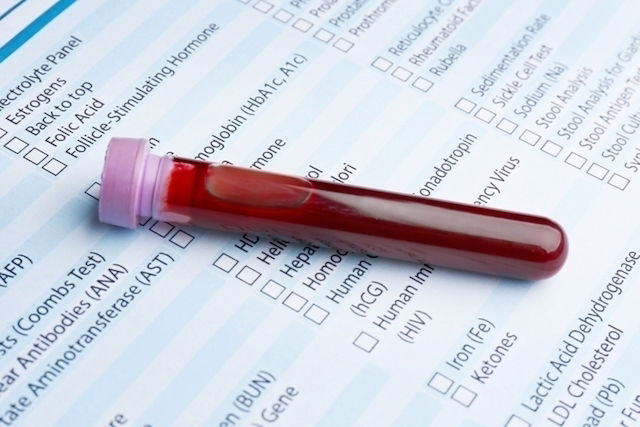The RDW blood test (red blood cell distribution width) measures the variation in red blood cell sizes, helping detect anisocytosis, which can be an early sign of anemia or nutritional deficiencies. It is usually part of a complete blood count (CBC) and analyzed along with other red blood cell markers, such as MCV.
This test is often ordered when symptoms like fatigue, dizziness, or pale skin are present, or as part of a routine health check. Abnormal results may indicate iron deficiency, vitamin B12 or folate deficiency, liver disease, or other blood-related conditions.
A high RDW level may prompt further testing to identify the underlying cause, while mildly low RDW values are typically not clinically significant. Interpreting RDW together with MCV helps doctors diagnose different types of anemia and evaluate overall health conditions.

RDW levels
The normal reference value for RDW is between 11 and 14%, however this reference range can vary from lab to lab. There are many reasons why values can be above or below this range, which is why blood tests should be interpreted by the ordering doctor.
High RDW levels
A high RDW, which is also known as anisocytosis, means that there is a significant variation between the size of your red blood cells. RDW can become elevated with severe or mild conditions, as outlines below:
People who are undergoing chemotherapy or who are taking antivirals may also present with increased RDW levels.
Low RDW levels
A low RDW is usually not of clinical significance on its own. A low result should generally be compared with other CBC results. It may be noted in people with a history of liver disease, kidney disease, HIV, cancer or diabetes.
When is RDW ordered?
Many times, this test is ordered to assess for anemia, especially in patients who present with symptoms like dizziness, fatigue or pale skin. The doctor may also order this test in patients who:
-
Have a family history of a blood disorder
-
Hemorrhaged during surgery or following direct trauma
-
Have been diagnosed with an illness that can cause blood cell abnormalities
-
Have a chronic disease, like HIV
Sometimes, this test is also ordered as part of a routine work-up, and not for any specific conditions.
RDW-CV vs RDW-SD
There are two ways to measure RDW: RDW-CV and RDW-SD.
RDW-CV is shown as a percentage and compares how much red blood cell sizes vary in relation to their average size. However, this number can be thrown off if the average size of the cells is unusually large or small.
RDW-SD, on the other hand, gives a direct measurement in units called femtoliters (fL). It doesn’t rely on the average size of the cells, so it tends to be more reliable when red blood cells are unusually big or small. RDW-SD may be especially helpful in spotting problems like iron deficiency or liver damage.
Interpreting RDW with MCV
RDW values are most informative when interpreted together with MCV. This combination helps identify different types of anemia and other health conditions. Read more about the MCV blood test and when it's ordered.
1. High RDW + Low MCV (Iron-Deficiency)
This is a classic pattern of iron-deficiency anemia, often appearing before other markers change. The elevated RDW reflects a mixed population of red blood cells as the body attempts to compensate for iron loss.
2. High RDW + High MCV (Megaloblastic)
Seen in vitamin B12 or folate deficiency. The high MCV indicates large, immature cells, while the high RDW reflects the variability between abnormal large and normal or fragmented cells.
3. Normal RDW + Abnormal MCV (Thalassemia, Chronic Disease)
Thalassemia trait often presents with low MCV and normal RDW because the red cells are consistently small. Anemia of chronic disease may show normal MCV and RDW, especially in early stages.
Summary table
How to prepare for this test
To prepare for a CBC blood test, you do not need to fast. However, CBC may be ordered with other blood tests that require a minimum of 8 hours of fasting.
Collecting blood usually takes less than 5 minutes. Samples are collected by puncturing the vein with a sterile needle and the blood is removed through a tube and into a vial.
FAQs
Check-out some other common questions about RDW that many patients have below:
1. What does a high RDW mean?
A high RDW (above 14.5%) indicates greater variation in red blood cell sizes and may suggest anemia, nutritional deficiency, or liver disease.
2. Can RDW be high without anemia?
Yes. RDW may be elevated in non-anemic individuals due to early iron deficiency, chronic inflammation, or underlying cardiovascular risk.
3. When should RDW prompt further testing?
Elevated RDW should lead to further testing for iron, folate, or vitamin B12 deficiency, and assessment for chronic or liver disease.
4. Is RDW useful for screening in healthy people?
RDW may serve as a general marker of health, frailty, and mortality, but it is primarily used to investigate causes of anemia.






























